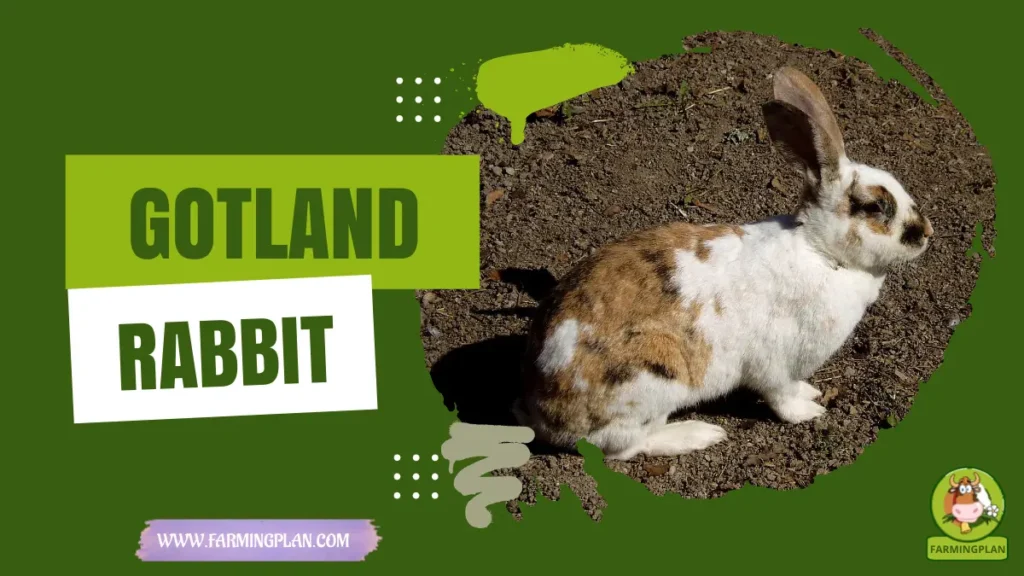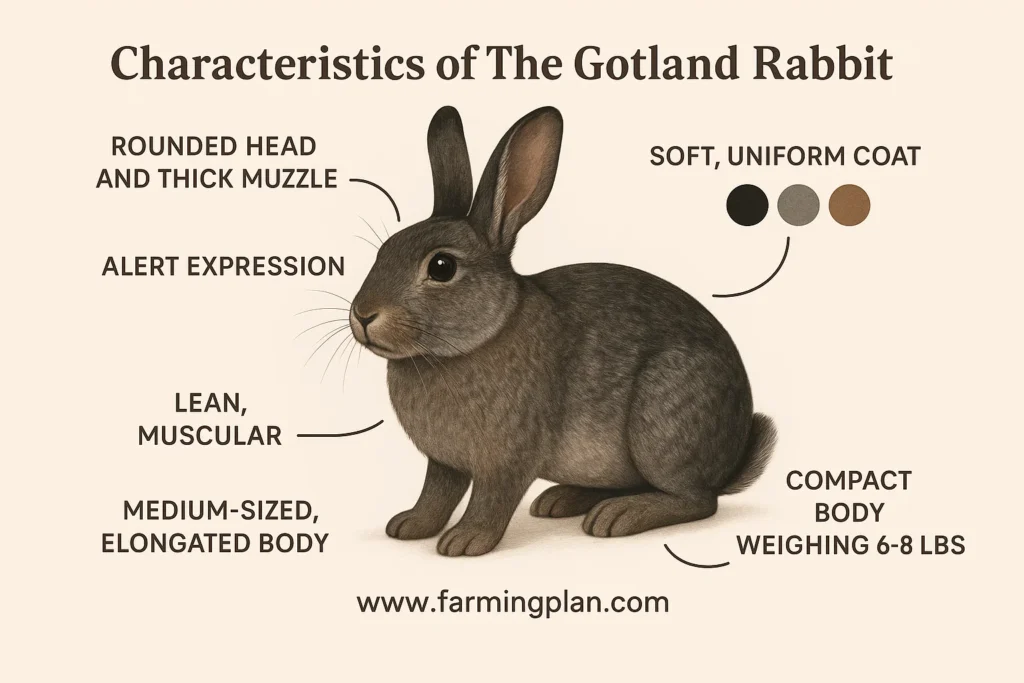If you’re looking for a rabbit breed that’s both unique and rich in heritage, let me introduce you to the Gotland Rabbit. With its round head, soft colorful coat, and curious nature, this Swedish landrace rabbit is more than just charming—it’s a living piece of history. Originally bred for meat and fur, Gotlands are now loved for their hardiness, sociability, and adaptability. I’ve raised several on my farm, and I’m always impressed by their friendly, active personalities. In this article, I’ll cover everything you need to know—from temperament and diet to health and care—whether you’re a breeder, hobbyist, or simply a rabbit enthusiast.

History & Origin of The Gotland Rabbit
The Gotland Rabbit, a breed that hails from Gotland Island, Sweden’s largest island, is a unique and indigenous breed. It is one of the few Swedish rabbits recognized as part of the official gene bank registry. Back in the day, these rabbits were raised on small farms for meat and fur, a result of careful, practical selection by farmers who valued strong nursing instincts, healthy litters, and easy maintenance.

Over time, as modern commercial breeds like the Rex rabbit and Swedish Giant Rabbit gained popularity, the Gotland Rabbit faced the threat of extinction. However, thanks to the dedication of a few breeders, this unique breed was saved. Through a conservation-focused breeding program, the Gotland Rabbit made a triumphant comeback in the early 2000s. Today, it stands as a symbol of sustainable, traditional farming and a testament to the resilience of heritage breeds.
What truly sets the Gotland Rabbit apart is its remarkable adaptability. Unlike many modern breeds, these rabbits are naturally resistant to diseases and can thrive in a variety of environments. This adaptability, coupled with their historical significance, makes them a unique addition to any farm-a living piece of history in your barn.
Read More: Angora Rabbit: Expert Guide to Soft Fiber
Characteristics of The Gotland Rabbit
Gotland Rabbits come in various coat colors, but they all share a few standout traits. Their medium-sized, elongated body is lean and muscular, a sign of their farm-hardy background. They usually weigh between 6 and 8 pounds, with compact bodies that move with grace and energy.

Their rounded heads and thicker muzzles give them a soft, approachable look. Unlike the narrow nose of some foreign rabbits, the Gotland’s face has an alert expression that shows their naturally curious behavior. The coat is soft and uniform, though you might see variation from rabbit to rabbit—blacks, greys, and browns are common. Their build reminds me of the Mellerud Rabbit, another landrace from Sweden. But the Gotland tends to be more active and aware of its surroundings. Whether you’re raising them as a farm animal or a pet, their body structure and energy make them easy to handle and fun to watch.
Read More: Amazing Altex Rabbit: The Ultimate Meat Bunny Choice
Nature & Temperament of The Gotland Rabbit
One thing I always tell new owners: the Gotland Rabbit has personality. These aren’t your average, docile lap bunnies. They’re alert, often hopping around and exploring their environment. They’re social animals, but also territorial, especially during the breeding season. So, if you’re housing more than one, make sure there’s plenty of space.

I find them to be curious animals—they’ll come up to you, sniff around, and follow you during chores. They do well with regular human interaction and can even bond with other animals if introduced properly. That said, don’t confuse their independence with aloofness. These rabbits enjoy company and form close ties with their caretakers. I always recommend keeping them in pairs or small groups to meet their social needs.
Read More: Vienna Rabbit: The Gentle Pet You’ll Instantly Love
Food & Diet
Feeding Gotlands is all about giving them a natural diet. On my farm, they get high-quality hay, like timothy or meadow hay, as their main food source. This keeps their digestion smooth and prevents digestive health issues. I also mix in some Traditional rabbit pellets, but only those without added sugars or artificial colorings.
Fresh greens—like non-toxic plants, dandelion leaves, and clover—are great for variety. Once or twice a week, I treat them with fruits like apple slices or a bit of carrot. But always keep it minimal—treats should never replace real food. Make sure they have access to plenty of fresh water daily. I recommend using a hay-lined litter box to help monitor hydration and urine color (a great tip for tracking health issues early!).
Usage & Purpose
Historically, the Gotland Rabbit was a type of farm rabbit used for rabbit meat and fur production. Though those uses have declined, they’re still considered healthy animals with good body weight and solid nursing instincts, producing large, manageable litters (often 6–8 kits per litter).
Today, they’re more popular in heritage rabbit showcases, breeding circles, and with conservation-focused hobbyists. Thanks to their sturdy bodies and social nature, they make delightful companion animals for families, homesteaders, or rabbit enthusiasts. What I like most is their flexibility. Whether you’re interested in sustainable farming or just want a lovable bunny, the Gotland fits the bill. They also serve educational purposes in animal preservation and breeding awareness programs.
Special Features
Here are a few things that make the Gotland Rabbit stand out:
- Indigenous rabbit breed with strong historical roots in Sweden
- Registered in Sweden’s official gene bank
- Known for large litters, hardy health, and adaptability
- Naturally resistant to common rabbit illnesses
- Social, active animals with an engaging, alert look
- Non-commercial landrace rabbit, preserving genetic diversity
Health Issues & Prevention
Gotland Rabbits are pretty tough, but like all domesticated animals, they can still face issues. Dental problems, overgrown nails, and digestive issues are the most common. Always check for dull coats, changes in appetite, or abnormal droppings.
To prevent problems, keep a clean environment, provide a balanced diet, and schedule regular grooming sessions with a Grooming Brush. I keep health logs for all my rabbits—weight, behavior, and eating habits. Watch for genetic illnesses, though rare in Gotlands thanks to careful breeding. Avoid overcrowding, as it can lead to hormonal behaviors and stress. If anything looks off, don’t hesitate to call your vet—or the animal poison control hotline if there’s a risk of toxic plants.
A Healthy Rabbit Starts With Nature’s Touch—Let Them Thrive With Fresh Food, Space, And Care.
Step-by-Step Pet Owner Care Guide
Step 1: Set Up A Safe Living Space
Start with a spacious hutch or enclosure, preferably outdoors with shelter. These rabbits love space, so aim for at least 10 square feet per rabbit. Use soft bedding like straw or hay and include a hay-lined litter box. Keep the area clean, dry, and draft-free. Add enrichment toys—like safe wood blocks or even a Scandinavian Rabbit toy—to keep them mentally active. Secure the area from predators, especially if you live near wildlife.
Step 2: Feed A Natural, High-Fibre Diet
Feed your Gotlands high-quality hay daily. That’s their main calorie source and supports digestive health. Supplement with greens, safe plants, and a small portion of traditional rabbit pellets. Provide fresh water at all times. I like to hand-feed my rabbits small treats now and then—it builds trust and lets me check their health up close. Stick to occasional treats, like a slice of banana or a few blueberries.
Step 3: Grooming & Daily Checks
Gotlands don’t need daily brushing unless they’re shedding, but a weekly grooming session helps with coat quality. Use a soft brush and check their coat uniformity, nails, teeth, and overall alertness. I keep a small notebook for each rabbit where I track any changes in behavior or body condition. Trust me—early detection is everything when it comes to health issues.
Step 4: Socialization & Behavior Monitoring
Gotland Rabbits are curious, social animals, so make time for interaction. Let them explore outside their enclosure safely, and talk to them—they really do respond to your voice. Be mindful of territorial behavior during the breeding season. Separate rabbits if signs of aggression show up. For breeding programs, make sure you match rabbits thoughtfully to avoid genetic issues and stress.
Expert Tips & Best Practices For Raising Gotland Rabbits
- Always source from reputable rabbit breeders listed in Sweden’s gene bank registry.
- Avoid commercial feeds loaded with sugar—natural diet equals a healthier rabbit.
- Groom weekly and check teeth, eyes, and nails regularly.
- Use hay-lined litter boxes to track urine color and keep cages clean.
- Keep a record of kits per litter to monitor breeding health.
- Rotate toys and objects to prevent boredom—active animals need variety.
- Use slow introduction methods when pairing unfamiliar rabbits.
- House them in quiet, shaded areas to reduce heat and noise stress.
Tip : Healthy Rabbits Don’t Just Happen—They’re Made With Time, Space, And A Touch Of Curiosity.
FAQ
How much does a Gotland Rabbit cost?
Prices vary, but a Gotland Rabbit usually costs between $50 to $150, depending on breeder, lineage, and location.
Where can I find Gotland Rabbits for sale?
You can find them through conservation breeders, online rabbit forums, or heritage breed networks in Sweden and Europe.
What is the lifespan of a Gotland Rabbit?
Gotland Rabbits typically live 8–10 years with proper care, diet, and a clean living environment.
Are Gotland Rabbits good pets for children?
Yes, they are curious and social but require space and gentle handling—great for responsible kids and families.
What makes Gotland Rabbits different from other breeds?
They’re an indigenous Swedish landrace known for their hardy nature, natural appearance, and unique gene bank registry status.
Conclusion
Raising a Gotland Rabbit isn’t just about having a cute, fluffy companion—it’s about becoming part of a living legacy. These hardy, curious animals are deeply tied to Sweden’s farming history, and today, they offer an amazing mix of personality, health, and practicality. Whether you’re a farmer looking to diversify, a breeder preserving native genetics, or a pet owner wanting a unique friend, the Gotland is a smart, sustainable choice. So, give them space, natural food, and some daily time—and you’ll be rewarded with one of the most delightful rabbits you’ll ever know.

